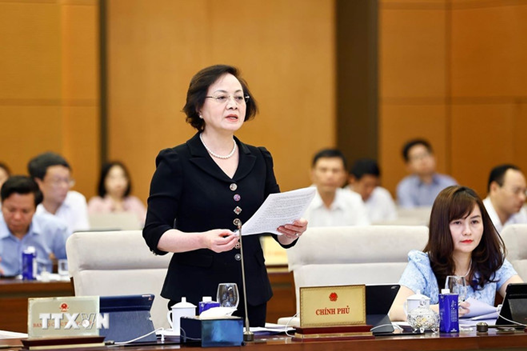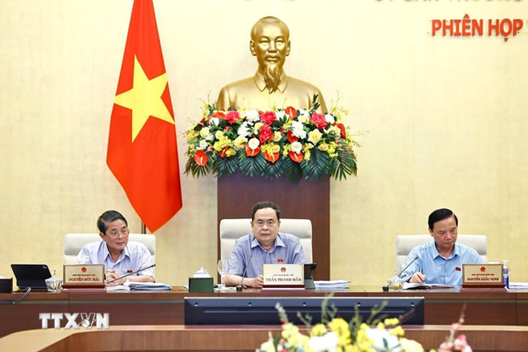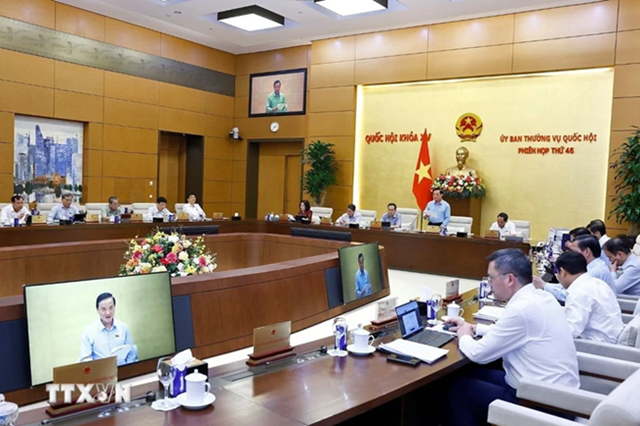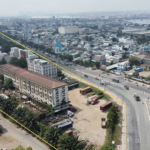
A bird’s eye view of the meeting. (Photo: Doan Tan/VNA)
|
In the afternoon of June 5th, the National Assembly Standing Committee discussed the proposal for rearranging provincial-level administrative units in 2025 and reviewed and passed, in principle, resolutions on rearranging communal-level administrative units in the same year. With a unanimous vote, the National Assembly Standing Committee passed, in principle, the resolution on rearranging communal-level administrative units.
After the National Assembly decides on the establishment of provinces and centrally-run cities and passes the Law on Local Government Organization, the National Assembly Chairman will sign and issue the resolutions of the National Assembly Standing Committee on rearranging communal-level administrative units.
Surplus of 4,226 Provincial-Level Public Offices
Presenting the Government’s proposal, Minister of Home Affairs Pham Thi Thanh Tra stated that, strictly adhering to Resolution No. 60-NQ/TW of the 11th Central Committee of the Party; based on the current situation and development orientation of 63 provinces and cities nationwide, the Government has developed 23 plans for rearranging 52 provincial-level administrative units to form 23 new ones.
After the rearrangement, the country will have 34 provincial-level administrative units, including 6 centrally-run cities and 28 provinces. “All 23/23 provincial-level administrative units formed after the rearrangement have met the orientation standards of provincial-level administrative units as stipulated in Article 4 of Resolution No. 76,” affirmed the Minister.
According to a summary from local authorities, after reviewing and agreeing on the method of calculating data as suggested by the Committee for Legal Affairs and Judiciary, the total number of public employees, including officials, civil servants, and public employees, allocated to the 52 provinces and cities undergoing rearrangement is 447,657 (including 2,321 officials, 79,118 civil servants, and 366,218 public employees).
After the local government at the provincial level comes into operation, the Government will direct the Ministry of Home Affairs to coordinate with the Central Organization Commission, provincial and municipal Party Committees, and relevant agencies to base themselves on the population scale, natural area, functions, tasks, and powers of the local government at the provincial level to build job positions and submit them to competent authorities for allocation of officials, civil servants, and public employees to localities.
Reduction of 6,714 Communal-Level Administrative Units
According to Minister Pham Thi Thanh Tra, out of the current total of 10,035 communal-level administrative units nationwide, 9,907 units will undergo rearrangement, and 128 units will remain unchanged (staying independent) as they have already met both standards of natural area and population scale or have specific factors (separate location) as stipulated in Resolution No. 76.

Minister of Home Affairs Pham Thi Thanh Tra presents a summary of the proposal. (Photo: Doan Tan/VNA)
|
The provinces and cities have developed 3,193 plans for rearranging 9,907 communal-level administrative units to form 3,193 new ones (including 2,498 communes, 682 wards, and 13 special districts), reducing 6,714 units.
As a result of the rearrangement of communal-level administrative units in 2025, the country will have 3,321 communal-level administrative units (including 2,621 communes, 687 wards, and 13 special districts), a reduction of 6,714 units (equivalent to a 66.91% reduction rate).
Among the 3,193 communal-level administrative units formed after the rearrangement, 3,036 units meet the orientation standards stipulated in Resolution No. 76 (accounting for 95.08%), and 157 units do not meet the orientation standards but cannot be further rearranged with adjacent communal-level administrative units (accounting for 4.92%).
Regarding the 157 communal-level administrative units that do not meet the orientation standards, the localities have provided explanations in the proposals, and the Government has agreed to apply the provisions of Clause 3, Article 5 of Resolution No. 76/2025/UBTVQH15.
The rearrangement and consolidation of agencies, organizations, and units after the rearrangement of communal-level administrative units must ensure the principle of unity and be in line with the rearrangement of Party organizations, the Fatherland Front, and socio-political organizations at the same level as guided by competent authorities.
Regarding the plan for arranging and assigning officials, public employees, and employees after the rearrangement of communal-level administrative units, Minister of Home Affairs stated that basically, the current district-level personnel will be rearranged and assigned to the newly formed communal-level administrative units; the current team of leading and managing officials of the political system at the district level will be mainly arranged to become the core of the newly formed communal-level administrative units. At the same time, a number of provincial-level officials, public employees, and employees will be assigned to the communal level. The activities of non-specialized staff at the communal level will be terminated, and their regimes and policies will be resolved according to the Government’s regulations.
157 Communal-Level Administrative Units Do Not Meet the Orientation Standards
Reviewing the Government’s proposals and plans for rearranging provincial-level and communal-level administrative units in 2025, Chairman of the Committee for Legal Affairs and Judiciary Hoang Thanh Tung stated that the Government’s proposals and plans had been prepared with great urgency, completing beyond the required progress, with full dossier components, and in the right order and procedure as prescribed.
“Through a review, the plans for rearranging provincial-level administrative units proposed by the Government have closely followed and ensured compliance with the directions and orientations of competent authorities. All 23 provincial-level administrative units formed after the rearrangement have met the standards of natural area and population scale as stipulated,” said Mr. Tung.
The Committee for Legal Affairs and Judiciary suggested that careful consideration should be given to determining whether the provincial-level administrative units formed after the rearrangement can be applied with the criteria for assessing mountainous and highland provinces, based on the province retaining its original name. According to the current guidelines and methods for applying criteria to determine mountainous and highland areas, a mountainous province is one where 2/3 of the districts are mountainous.
Therefore, when merging provinces, including mountainous and highland ones, it is suggested to base on the above criteria to determine whether the province formed after the rearrangement is a mountainous or highland province, so as to apply appropriate assessment standards for provincial-level administrative units and serve as a basis for continuing to implement regimes and policies for mountainous and highland areas while waiting for new regulations and classification methods on this matter.

National Assembly Chairman Tran Thanh Man speaks. (Photo: Doan Tan/VNA)
|
Regarding the plans for rearranging communal-level administrative units, Mr. Hoang Thanh Tung said that among the 3,193 communal-level administrative units formed after the rearrangement, 3,036 units (95.08%) have met the orientation standards stipulated, with the majority formed on the basis of merging three or more communal-level administrative units (accounting for 65.44% of the total number of plans), so there is no need to consider the orientation standards.
However, some plans, although merging three or more communal-level administrative units, still result in units that do not meet 100% of the orientation standards in terms of both natural area and population scale.
For the 157 units formed after the rearrangement that have not met the orientation standards, most of them have been explained by the Government in the proposals, with sufficient grounds for submission to the National Assembly Standing Committee for consideration and decision-making according to Clause 3, Article 5 of Resolution No. 76; only a few proposals lack explanations (in the provinces of Tuyen Quang, Quang Ngai, Dong Thap, Ho Chi Minh City, and Ninh Binh).
In addition, some rearrangement plans are not really reasonable, but the proposals do not contain explanations or show inconsistencies among localities in rearranging communes and wards to form wards or communes (in the provinces of Ha Tinh and Ho Chi Minh City).
At the review session, the Government provided additional information on these cases, and the Committee for Legal Affairs and Judiciary basically agreed with the Government’s explanations. The Committee for Legal Affairs and Judiciary requested the Government to provide additional information on the policy of building a resolution of the National Assembly on piloting mechanisms and policies for the special development of Van Don Special Economic Zone, Quang Ninh province, clarifying whether the implementation of this policy will affect the plan for rearranging communal-level administrative units in Quang Ninh province or not, so as to have a suitable solution.
Regarding the criteria for assessing mountainous and highland areas, Vice Chairman of the National Assembly Tran Quang Phuong suggested not mentioning this issue in the resolution. The Party’s policy is that provinces with forests, seas, and borders cannot be considered mountainous or highland provinces. The criteria for assessing mountainous and highland areas only apply to the communal level.
Appreciating the Government, the Ministry of Home Affairs, and the Committee for Legal Affairs and Judiciary for their urgent and proactive work, National Assembly Chairman Tran Thanh Man stated that a large amount of work had been completed. Localities have shown great interest and initiative in rearranging administrative units.
National Assembly Chairman Tran Thanh Man noted that the resolution of the National Assembly Standing Committee on rearranging communal-level administrative units must be concise and clear, ensuring legality and compliance with the regulations of the Party and the State.
The Ministry of Home Affairs, the Committee for Legal Affairs and Judiciary, and relevant agencies should continue to review the names of administrative units, data, and other details to ensure accuracy and correctness in the resolution, which will be promulgated according to the roadmap set by the Central Steering Committee. Continue to create consensus among the people.
Chu Thanh Van
– 17:32 06/05/2025
The Government Streamlines: Over 23,000 Civil Servants Depart Through Structural Reforms
The Ministry of Home Affairs has revealed an alarming trend – over 23,000 civil servants have resigned, and an additional 9,000 are expected to leave soon, in accordance with current regulations. This mass exodus of talent poses a significant challenge to the efficient functioning of the government machinery.
A Dynamic Approach to Administrative Efficiency: Exploring Multi-Site Operations for a Seamless Transition
I hope that captures the essence of your request. Let me know if you would like me to elaborate on this title or provide any additional creative inputs.
“In a recent directive, the Prime Minister has outlined a strategic approach to managing the transition during the initial stages of administrative unit reorganization. Acknowledging the challenges posed by infrastructure and transportation logistics, the directive emphasizes the importance of maintaining multiple office locations. This decision aims to ensure uninterrupted governance in merged territories and alleviate travel and lifestyle inconveniences for civil servants and employees. The primary objective is to uphold seamless public service delivery to citizens without any disruptions.”
“National Assembly Standing Committee Reviews Proposal for 2025 Provincial-Level Administrative Unit Restructuring”
The upcoming legislative agenda includes three key bills: the Local Government Organization Law, the Civil Servants and State Employees Law (amended), and a proposal for the rearrangement of provincial-level administrative units for 2025. The National Assembly Standing Committee will provide feedback on these critical initiatives, offering insights and guidance to shape the future of local governance and civil service regulations in the coming year.














































